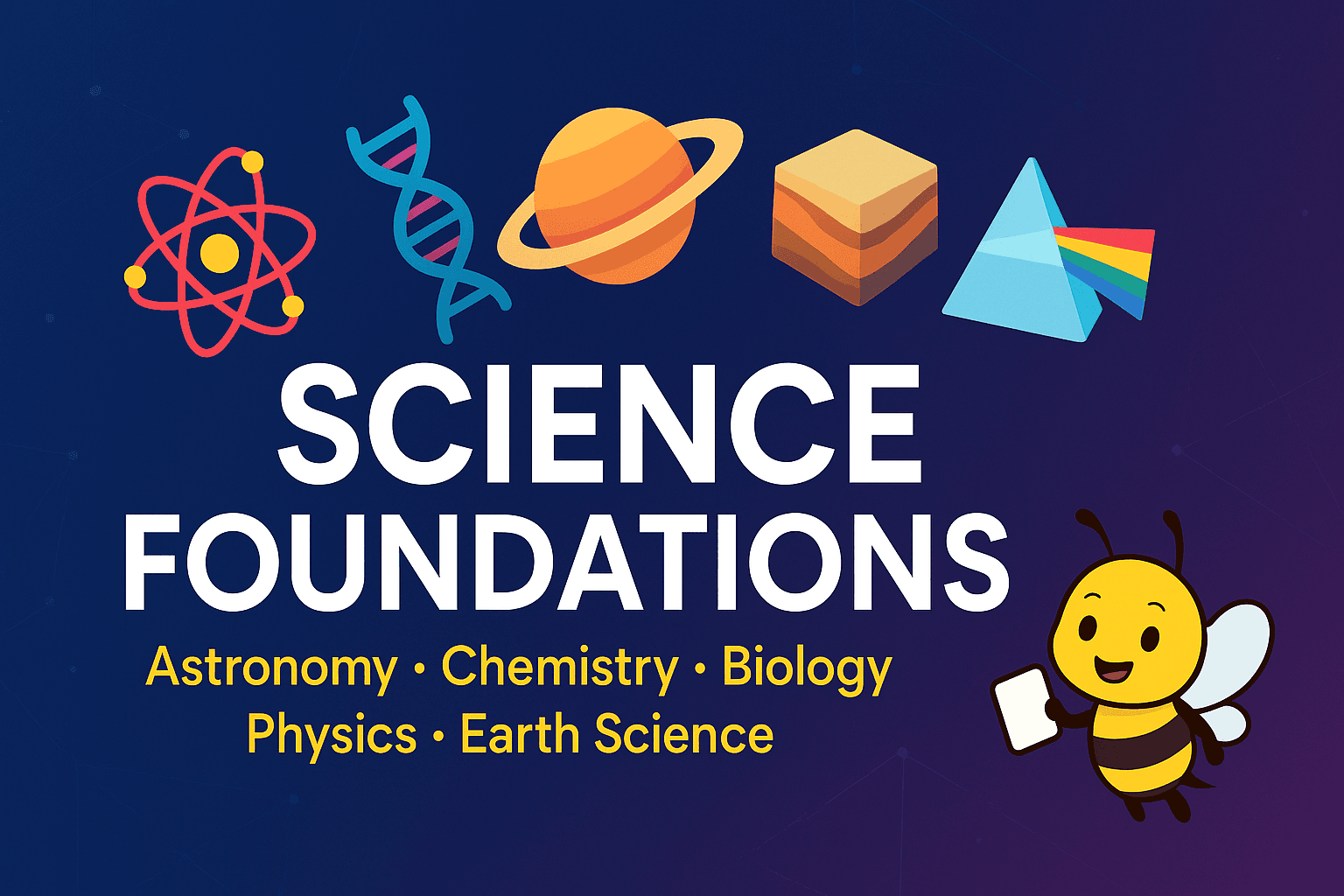Science 1
Concept-focused guide for Science 1.
~8 min read

Overview
Welcome, learners! In this session, we’ll explore foundational and advanced science concepts across astronomy, chemistry, biology, physics, and Earth science. You’ll gain a practical understanding of phenomena such as atomic structure, geological processes, energy transformations in living cells, and the physical principles that shape our universe. We’ll break down each topic with clear explanations, visual reasoning, and generic worked examples—helping you build strong intuition and problem-solving confidence for any science exam.
Concept-by-Concept Deep Dive
Atomic Structure, Periodic Table, and Chemical Bonding
What it is:
Atomic structure refers to the arrangement of subatomic particles (protons, neutrons, electrons) within atoms, which determines the identity and properties of elements. The periodic table organizes elements based on atomic number and similar chemical behaviors, while chemical bonding explains how atoms combine to form compounds.
Key Subtopics:
-
Noble Gases and Reactivity:
Noble gases are found on the far right of the periodic table. They have full valence electron shells, making them generally unreactive because they are energetically stable. -
Groups and Periods:
Elements are classified by vertical columns (groups) and horizontal rows (periods). For example, Group 2 elements (alkaline earth metals) share similar properties, like forming +2 ions. -
Atomic Radius Trends:
Atomic size changes across periods and down groups. Across a period (left to right), atoms get smaller due to increasing nuclear charge pulling electrons closer. Down a group, atoms get larger due to additional electron shells. -
Structural Formulas and Functional Groups:
Organic molecules like methane or ethanol have characteristic structural formulas and contain functional groups (like hydroxyl in alcohols).
Reasoning Recipe:
- Identify the number of protons (atomic number) to locate elements.
- Use group and period trends to predict properties (e.g., atomic radius, reactivity).
- Draw or interpret structural formulas, noting the arrangement of atoms and bonds.
Common Misconceptions:
- Confusing periods (horizontal) with groups (vertical).
- Assuming noble gases are reactive because they are gases.
- Forgetting that atomic radius decreases across a period.
Cellular Processes and Biomolecules
What it is:
Cells carry out complex processes to sustain life, such as respiration, fermentation, and genetic information flow (central dogma). Biomolecules like proteins, carbohydrates, nucleic acids, and lipids are fundamental to these processes.
Key Subtopics:
-
DNA and Central Dogma:
DNA holds genetic information. The central dogma describes the flow: DNA → RNA → Protein. Transcription makes RNA from DNA; translation makes protein from RNA. -
ATP Production and Cellular Respiration:
Cellular respiration involves glycolysis, the Krebs cycle, and the electron transport chain. The majority of ATP is produced in the final stage. -
Fermentation:
When oxygen is scarce, cells use fermentation for ATP production, regenerating molecules needed for glycolysis to continue. -
Types of Biomolecules:
Proteins are chains of amino acids linked by peptide bonds; carbohydrates are primary energy sources; nucleic acids store genetic material.
Reasoning Recipe:
- Trace the flow of information or energy (e.g., DNA → mRNA → Protein or glucose → ATP).
- Identify stages of processes and what occurs at each step.
- Recognize structural features (e.g., peptide bonds in proteins).
Common Misconceptions:
- Mixing up transcription and translation.
- Underestimating ATP yield at each stage of respiration.
- Assuming all biomolecules provide energy equally.
Earth’s Structure, Minerals, and Rocks
What it is:
Earth’s structure consists of layers (core, mantle, crust) with distinct compositions and states. Minerals are naturally occurring compounds; rocks form from mineral assemblages and geologic processes.
Key Subtopics:
-
Layers of Earth:
The inner core is solid, mostly iron and nickel. The mantle is thick and semi-solid. The crust is thin and composed mainly of silicate minerals. -
Rock Types:
- Sedimentary: Formed from accumulated sediments, often show layers and fossils.
- Igneous: Formed from cooled magma/lava, may have interlocking crystals.
- Metamorphic: Formed under heat/pressure, with altered structures.
-
Minerals in Earth’s Crust:
Quartz (silicon and oxygen) is abundant. Rock composition often reflects mineral content. -
Stratigraphy and Geologic Time:
Layers provide records of Earth’s history; principles like superposition help determine relative ages.
Reasoning Recipe:
- Identify the distinguishing features of each rock type.
- Use structural or compositional clues to infer origin/layer.
🔒 Continue Reading with Premium
Unlock the full vlog content, professor narration, and all additional sections with a one-time premium upgrade.
One-time payment • Lifetime access • Support development
Join us to receive notifications about our new vlogs/quizzes by subscribing here!